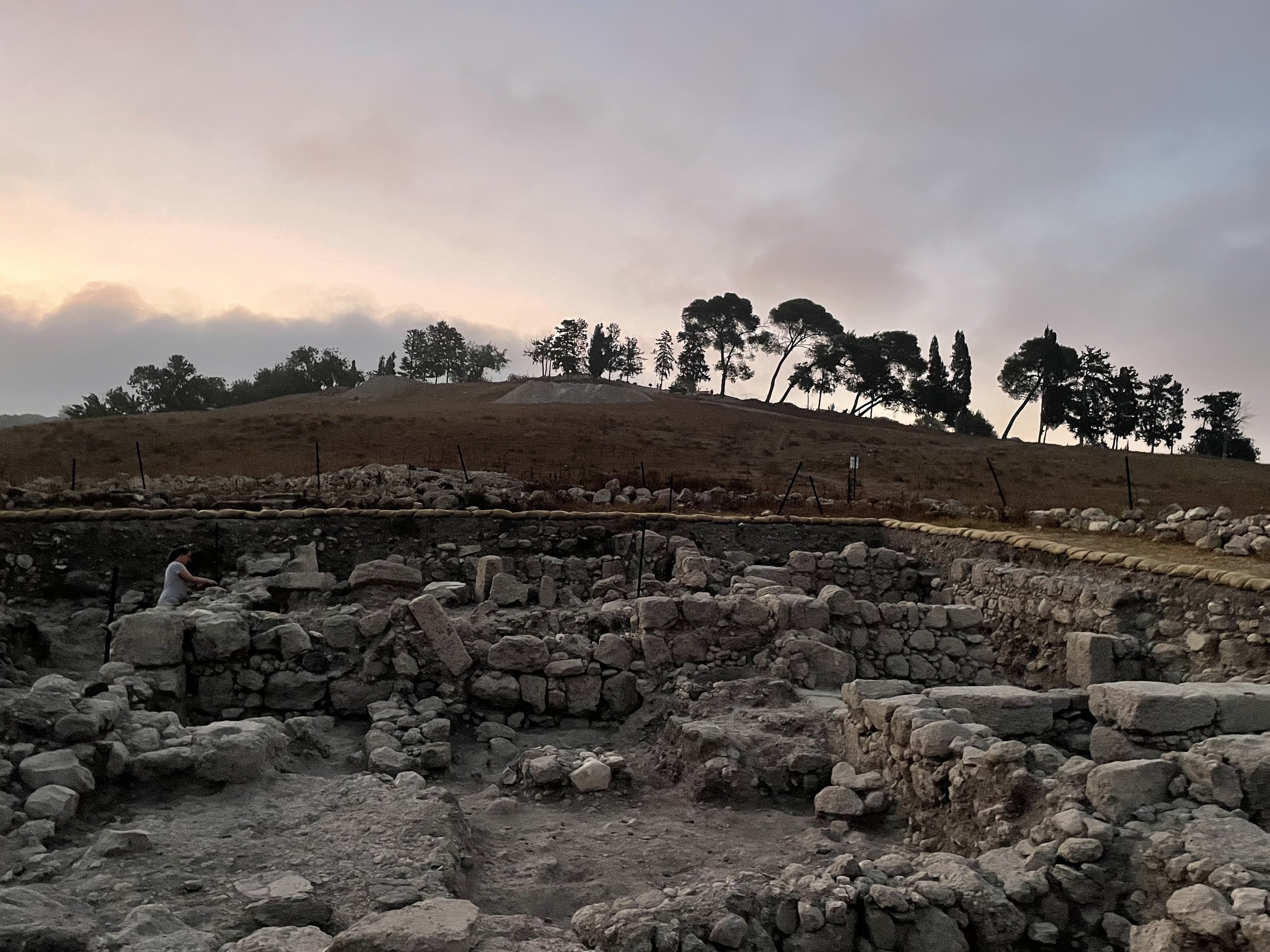
Iron Age Research Questions
By Daniel Master and Joshua T. Walton
While Tel Shimron appears as a prominent city (Shimcon, Rainey 1976, 1981) in many Bronze Age texts, its role in the Iron Age is shrouded in mystery. According to the Hebrew Bible, (Joshua 19:15) Shimʿon was part of the tribal allotment of Zebulun. The Hebrew Bible mentions that the king of Shimcon (LXX) was an ally of the king of Hazor (Joshua 11:1) and both were defeated in a battle in the hills of Galilee. Joshua 12, likely drawing on the same tradition, also remembers the king of Shimcon (LXX) as one defeated by the Israelites. These texts state nothing about the particular fate of the Bronze Age city, but the very paucity of references within the Hebrew Bible implies that the Iron Age, in its entirety, was a time of diminished power and influence for the city of Tel Shimron. A similar impression was given by the initial surveys of the site, which found that the Iron Age occupation was likely restricted to the upper part of the tel (Raban 1982), diminishing in size to 30–40 dunams by the Iron II (Portugali 1982, 183–87).
Late Bronze-Iron Age Transition: Gal (1992, 87) argued that those regions of Galilee whose Late Bronze Age cities were destroyed in the LBII saw the proliferation of small highland villages in the 12th century. The villages, characterized by four-roomed houses and collared rim storage jars, have been frequently linked with early Israelite settlement (Faust 2006, 65–84). In contrast, village growth did not occur in areas where urban life lasted into Iron I (Gal 1992, 87), a phenomenon Israel Finkelstein has described as New Canaan (2013, 28–32). Gal argued that the Nazareth ridge, immediately adjacent to Tel Shimron saw substantial new village settlement in the Iron I (1992, 88–90), but that the Jezreel Valley was an area with continuity of settlement between the LB and Iron I (ibid. 84). Excavation at Tel Shimron can test whether the destruction of the Canaanite urban center at Tel Shimron may have influenced regional settlement patterns or if Shimron provides another example of continuity of Canaanite culture into the early Iron I which is found at other sites in the Jezreel Valley such as Megiddo (Finkelstein 2013, 30). The nature of the transition from the Bronze to the Iron Age has substantive implications for the history of the region, and these questions can only be addressed through stratigraphic excavation (Portugali 1982).
Iron Age Cultural Affinities: In studying the development of the Iron Age, it will be important to determine whether the site’s Iron 1 cultural affinities are to Galilee, the Jezreel Valley, or the Acco Plain because of the fundamentally different ways in which each of these zones related to the emergence of the highland kingdoms of the Iron 2. By the ninth century, the site of Shimron would surely have fallen under the sway of the Kingdom of Israel, and some would place the reference to the site in Joshua 19 in such a context. It could equally be the case that the site was more closely oriented to the west, being linked to the Phoenician coast by routes that cross the Shephelah of Galilee. Understanding the relationships between Iron Age Shimron and regions of Samaria and the Acco plain will provide insight into the challenges faced by the whole of lower Galilee in the early first millennium.
The Rise of Assyria: During the 9th and 8th centuries, this region was progressively denuded by conflicts between the Israelites, Aramaeans, and Assyrians. Sites to the north of Tel Shimron such as Horvat Rosh Zayit seem to have been destroyed quite early in the sequence (ca. 880 BCE, likely at the hands of the Aramaeans, Gal and Alexandre 2000, 200). Others such as Tel Megiddo (Peersmann 2000; Reich 1992, 216–18), Kinrot (Fritz 1990, 99–102), and Hazor (Kletter and Zwickel 2006) were taken by Tiglath-Pileser III in the eighth century (cf. also 2 Kings 15:29) and re-emerged as outposts of the Assyrian empire. Na’aman (1993, 106), Younger (1998, 212), and Rainey and Notley (2006, 231) have argued that Tel Shimron also fell to Tiglath-Pileser III during one of his campaigns against Israel between 734 and 732 BCE. A broken fragment on Tiglath-Pileser III’s Annals (Ann 18, 24) lists the fate of “16 districts of Bit-Humri (Israel)” which were leveled to the ground and their populations exiled. The list includes primarily towns from the lower Galilee and along the Jezreel Valley. One of the towns lists is badly broken, but has been reconstructed by Na’aman as Samhuna, which he identifies with the site of Tel Shimron (1993, 106). This text has led to the hypothesis that following this campaign the majority of Israel’s holdings were already stripped by the Assyrians and re-organized under the provincial center at Megiddo, with only the immediate environs of Samaria maintaining a small degree of autonomy as a vassal state (Na’aman 1993, 105; 1995, 274). Based on survey data, Gal (1992, 108) argued that following this campaign the area of the lower Galilee, in particular the holdings of Zebulun, were devastated, the inhabitants exiled, and the lands left deserted. Excavations at Tel Shimron can further elucidate the events of Tiglath-Pileser III’s 734–732 campaigns and their effects on the north as well as the important question of Assyrian administrative presence and resettlement of the region.
Bibliography
Faust, Avraham. 2006. Israel’s Ethnogenesis: Settlement, Interaction, Expansion, and Resistance. London: Equinox.
Finkelstein, Israel. 2013. The Forgotten Kingdom: The Archaeology and History of Northern Israel. SBL Ancient Near East Monographs 5. Atlanta: Society of Biblical Literature.
Fritz, Volkmar. 1990. “Der ‘Assyrische’ Palast (Gebaude 737).” In Ergebnisse Der Ausgrabungen Auf Dem Tell El-’Oreme Am See Gennesaret 1982-1985, edited by Volkmar Fritz, 99–102. Wiesbaden: Harassowitz.
Gal, Zvi. 1992. Lower Galilee During the Iron Age. American Schools of Oriental Studies Dissertation Series 8. Winona Lake, IN: Eisenbrauns.
Gal, Zvi, and Y. Alexandre. 2000. Horbat Rosh Zayit: An Iron Age Storage Fort and Village. IAA Reports 8. Jerusalem: Israel Antiquities Authority.
Kletter, Raz, and Wolfgang Zwickel. 2006. “The Assyrian Building of ‘Ayyelet Ha-Sahar.’” Zeitschrift Des Deutschen Palästina-Vereins 122 (2): 151–86.
Na'aman, N. 1993. “Population Changes in Palestine Following Assyrian Deportations.” Tel Aviv 20: 104–24.
______ 1995. “Tiglath-Pileser III’s Campaigns Against Tyre and Israel (734-732 BCE).” Tel Aviv 22: 268–78.
Peersmann, Jennifer. 2000. “Assyrian Magiddu: The Town Planning of Stratum III.” In Megiddo III: The 1992-1996 Seasons, edited by Israel Finkelstein, David Ussishkin, and Baruch Halpern, II:524–34. Tel Aviv: Emery and Claire Yass Publications in Archaeology of the Institute of Archaeology, Tel Aviv University.
Portugali, Yuval. 1982. “A Field Methodology for Regional Archaeology (The Jezreel Valley Survey, 1981).” Tel Aviv 9/2: 170–88.
Raban, Avner. 1982 Archaeological Survey of Israel: Nahalal Map (28) 16–23. Jerusalem: Archaeological Survey of Israel.
Rainey, Anson. 1976. “Toponymic Problems (cont.).” Tel Aviv 3: 57–69.
______ 1981. “Toponymic Problems (cont.).” Tel Aviv 8: 146–51.
Rainey, Anson, and Steven Notley. 2006. The Sacred Bridge: Carta’s Atlas of the Biblical World. Jerusalem: Carta.
Reich, Ronny. 1992. “Palaces and Residences in the Iron Age.” In The Architecture of Ancient Israel: From the Prehistoric to the Persian Periods, edited by Ronny Reich and Aharon Kempinski, 202–22. Jerusalem: Israel Exploration Society.
Younger, K. Lawson. 1998. “The Deportations of the Israelites.” Journal of Biblical Literature 117 (2): 201–27.
